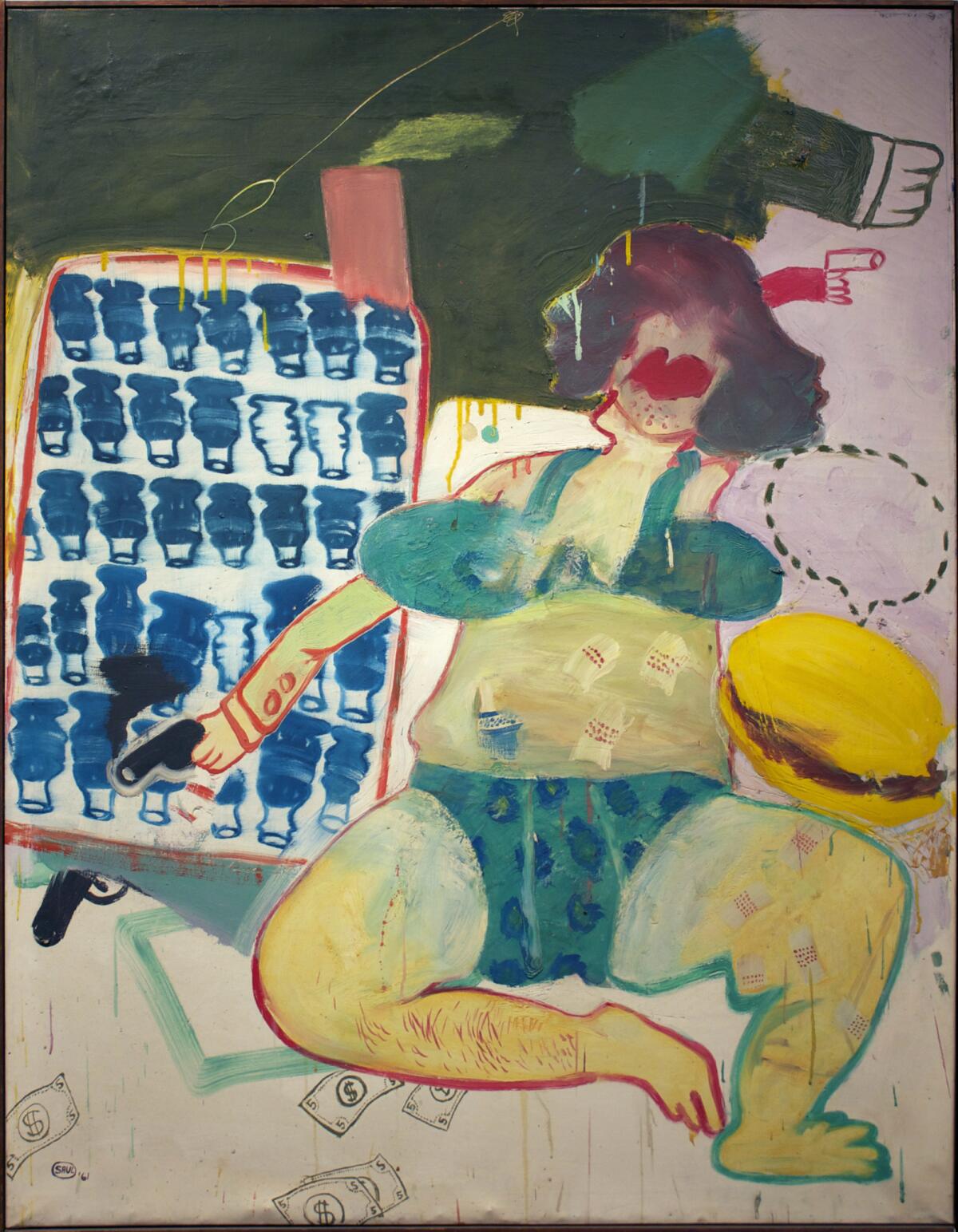Review: From brash Pop to a more complicated mix: Peter Saul at CB1-G
A canned good here, a super hero there — and isn’t that Olive Oyl (or perhaps her doppelganger) opening the door to 1961’s “Refrigerator #3,” lined with jiggly rows of identical soda bottles from the supermarket?
In a painting like this, it’s easy to see why Peter Saul was received as a brash, pioneering Pop artist in the early 1960s, when commercial subject matter was busily kicking pure abstraction in the teeth. Saul did it with notable glee.
At George Adams Gallery at CB1-G, three paintings, 16 works on paper and one painted sculpture track aspects of the transformation Saul’s work underwent from 1957 to 1967. The Pop aspect is inescapable (and inescapably new for painting); but so is an established Surrealist sense of warped time/space dislocation and gestural paint-handling with Expressionist verve. In combination with vernacular subject matter, the mix sets his work apart.
In a typical Saul painting or drawing, German expatriate social-observer Max Beckmann collides with jingoist all-American Thomas Hart Benton within an abstract structural armature of Willem de Kooning, all slathered with a cheeky overlay of Mad Magazine irreverence. It’s quite a mash-up, one that was nicely articulated in the small but powerful 2008 survey of Saul’s career shown at the Orange County Museum of Art.

“Gun Moll” is emblematic — a grotesque, De Kooning-style woman dressed in bra and panties, smashed against a graffiti-marked wall, dripping dollar bills, wielding a handgun and chatted up by a giant, floating hamburger. The casual violence of both the picture’s substance and its brushy, acrid colors is at once dark and funny, horrific and sad.
Drawings are among the show’s standouts. Rather than the public bleating of urban street-graffiti, which would have such a profound impact on late 1970s and ’80s art, his scrawled drawings meditate on the private fears and lonely viciousness expressed on the walls of toilet stalls. The secretive inner workings of humanity head toward sordid public expression.
Saul was born in San Francisco in 1934 and lived mostly in Paris when the earliest works were made. Returning to the U.S. in 1964 as the Vietnam War ground on, he soon examined American militarism. A grim trio of examples concludes this modest but bracing show.
One is a raucous 1967 painting of Green Berets raping and bombing in a delirious orgy of brutality; the others are a garish lithograph and a painted sculpture, both showing an American soldier nailed to a cross. Saul’s impure, hybrid style is just the right vehicle to convey the war’s haunted complexity, where abused victims and heroic saviors can sometimes be one and the same.
George Adams Gallery at CB1-G, 1923 S. Santa Fe Ave., Los Angeles. Through Feb. 18; closed Mondays and Tuesdays. (213) 806-7889, www.cb1gallery.com
ALSO
The Lucas Museum of Narrative Art is a bad idea. Here's why
Edmé Bouchardon's drawings changed the way sculpture looked
Hammer Museum finally cues up a big expansion. Here's an early look
The biggest entertainment stories
Get our big stories about Hollywood, film, television, music, arts, culture and more right in your inbox as soon as they publish.
You may occasionally receive promotional content from the Los Angeles Times.








